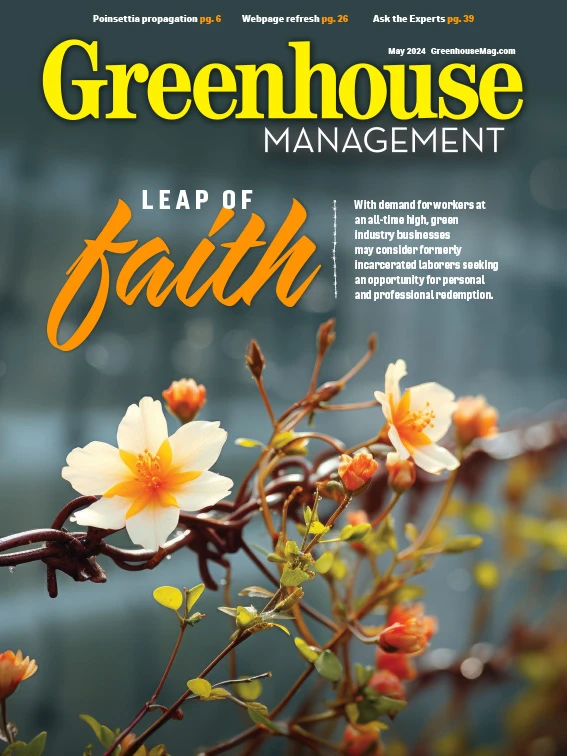
Dariusz Malinowski’s groundbreaking hibiscus breeding work began as a personal quest to bring more color into his own landscape. A plant physiologist who earned his master’s degree in horticulture in Poland and a life sciences Ph.D. in Switzerland, Malinowski bought a house in Vernon, Texas, in 2004 while researching forage grasses at Texas A&M AgriLife Research and Extension Center. While filling his new backyard with plants, he discovered winter-hardy hibiscus.
“I fell in love with them immediately,” Malinowski says. “I wanted to buy more colors, but I quickly figured out that only cultivars with pink, red and white flowers were available on the market. So, I decided to create more colors.”
Malinowski spent three years hybridizing winter-hardy hibiscus at home before he caught the attention of Steve Brown, then-director of Texas Foundation Seed Service, who walked by his office one day and spotted pictures of his cutting-edge color palette. Brown encouraged Malinowski to make his hobby an official part of Texas A&M AgriLife Research, leading to the launch of his winter-hardy hibiscus breeding program in 2010 and a tropical hibiscus breeding program in 2014.

Colorful objectives
Malinowski’s first goal was creating blue flowers.
“It was quite challenging because blue pigment did not exist in winter-hardy hibiscus,” he says. “It took four generations of hybrids for the first mauve-bluish flower colors to appear. It took another 60 parents and nine breeding cycles to finally create a plant with almost blue flowers. Using the gene-stacking method, we’ve been able to create a hybrid with bluish flower color and dark purplish foliage.”
Early on, Malinowski’s novel colors captivated home gardeners and commercial growers. While hobbyist gardeners were eager to acquire his rare colors, Malinowski quickly learned that commercial partners were looking for different traits “such as compact growth and natural branching,” he says, “traits related to the production and transport of plants, not necessarily to the beauty of the flowers.”
To satisfy consumers and commercial partners alike, Malinowski had to balance beauty and utility. His first bluish-hued hybrid, Blue Angel, didn’t have the most stable color or desirable growth characteristics. But it led to more than 30 blue-flowering lines, producing hybrids like Bleu Brulee and Cordon Bleu, which were both commercialized by J. Berry Nursery in 2018.
Malinowski’s program has disclosed more than 480 unique winter-hardy hibiscus hybrids to the Texas A&M Innovation office, about a dozen of which have been commercialized by J. Berry through the Summer Spice Hardy Hibiscus series, and 240 tropical hibiscus hybrids, one of which has been commercialized.

Rebuilding the research program
At the program’s peak, Malinowski’s research team planted about 2,500 hibiscus hybrids every year — judiciously selecting the most promising flower colors and growing habits to cross. Initially, he grew everything in a 2-acre field, but heat impeded the cross-pollination process.
“The pollen of winter-hardy hibiscus is only viable in temperatures around 80 to 85 degrees [Fahrenheit], so I had to do the crossings very early in the morning, because by 11 o’clock in the summer, we’re already over 90 degrees,” he says. To better control the breeding environment, Malinowski began propagating cuttings in greenhouses around 2016.
By May 2022, his hibiscus breeding program filled about 8,000 square feet of greenhouse space in addition to the 2-acre field. But then a tornado ripped through the area, destroying all three greenhouses and the Texas A&M AgriLife Research and Extension Center headquarters. Malinowski saved about 200 tropical and 150 hardy hibiscus from the debris and temporarily moved them into a greenhouse at a nearby high school. The Texas A&M administration also set up a hoophouse as a temporary home for the breeding program.
The field-grown winter-hardy hibiscus survived the storm — sparing most of Malinowski’s genetic collection, which spans about 20,000 plants. He has seeds of another 2,500 tropical hybrids and 1,000 hardy hybrids currently frozen, awaiting the new greenhouses. The new research headquarters should be completed by the summer of 2025, he says, “and we hope the greenhouses will be rebuilt by then, too.”

The next frontier
Having pioneered many novel hardy hibiscus colors including magenta, silver, maroon and purple, Malinowski’s next goal is creating orange and yellow pigments that don’t exist in this species.

“It seems even more difficult than creating blue flowers, but we have succeeded in achieving the first hybrid with a coral flower color,” he says, noting that it will be further bred for improved shape and dark foliage. “This is just the first step, but we’re headed in the right direction.”
He’s also working on serrated petals and multi-petal flowers, with the goal of transferring both traits to his colorful palette of winter-hardy hybrids. Since tropical hibiscus already feature myriad color combinations, that program focuses instead on “novel plant characteristics,” like extended blooming time and growth habits suited for hanging baskets.
“I still have a few goals I want to complete before retirement,” which is about 10 years away, Malinowski says. “Plant enthusiasts keep asking for new cultivars, which ensures that my work is important, noticed and appreciated.”
Brooke Bilyj owns and operates Bantamedia, a national award-winning content, PR and SEO firm based in Cleveland. She is a frequent contributor to GIE Media's horticulture publications.
Explore the May 2024 Issue
Check out more from this issue and find your next story to read.
Latest from Greenhouse Management
- Anthura acquires Bromelia assets from Corn. Bak in Netherlands
- Top 10 stories for National Poinsettia Day
- Langendoen Mechanical hosts open house to showcase new greenhouse build
- Conor Foy joins EHR's national sales team
- Pantone announces its 2026 Color of the Year
- Syngenta granted federal registration for Trefinti nematicide/fungicide in ornamental market
- A legacy of influence
- HILA 2025 video highlights: John Gaydos of Proven Winners





